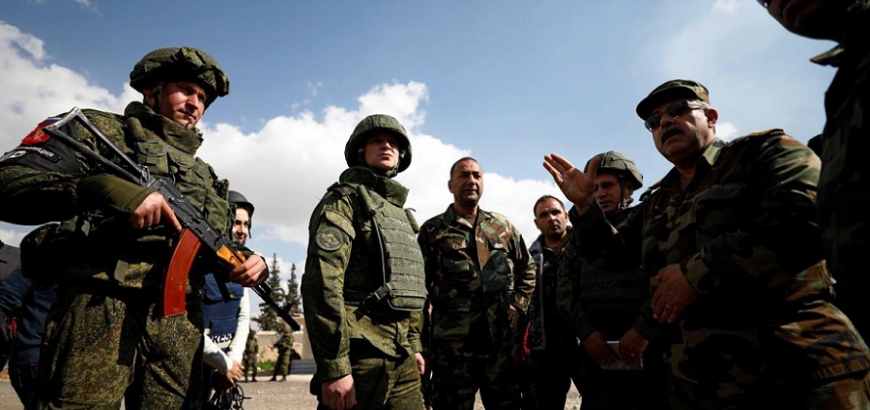With the Bashar al-Assad regime and its allies taking control over 90 percent of the Eastern Ghouta, and the city of Douma the only one remaining under the control of the Jaish al-Islam, which is entering into negotiations with the Russians, there are now questions over the future destination for the regime’s coming military operations.
Analyses over the last few days have pointed to the major possibility that the areas under control of rebel groups in Syria’s south could be the regime’s next stop after neutralizing the Eastern Ghouta and pushing it out of the circle of conflict, which the regime has considered a worrisome factor for years due to its proximity to Damascus and the heavy volume of losses which its forces have suffered during its many attempts to storm it.
The southern front is one of the biggest remaining strongholds of the Syrian opposition alongside Idleb, and the regime has repeatedly tried to regain control over it and to separate opposition areas from one another, however it has not yet succeeded.
This front is particular because of its proximity to the Jordanian border and the territory occupied by Israel, and due to the presence of American forces nearby.
Securing Damascus' perimeter
An expert on Syrian affairs, Salah Malkawi, said that the southern front would not be the next step for the regime after the Eastern Ghouta, and expects that they will head toward southern Damascus first and then to Eastern Qalamoun, which are both outside regime control.
Malkawi told Alsouria Net on Thursday that the regime was currently trying to secure the entire regime environs and expel the opposition, noting that this is a priority for the regime.
He believes that the regime and Russia are intent on taking control over Syria’s southern region, “whatever the price” but that they are delaying this for a later stage. He said that for the regime, the Qalamoun area falls in the capital's environs and therefore Assad sees more importance there than in Daraa, and then after that the opposition areas in the Homs countryside, Hama, and then the south.
Qalamoun
Eastern Qalamoun has once again returned to the forefront, as part of the discussions ongoing between Jaish al-Islam and the Russians, and the leaks from these negotiations indicate one of the possible options being discussed is to transport Jaish al-Islam fighters to Eastern Qalamoun, where they have forces.
Alsouria Net contacted Jaish al-Islam to find out the truth of the possibility of transporting fighters to Qalamoun, but did not receive a response by the time of writing this report.
Malkawi said that the ones holding up the settlement with Jaish al-Islam were the Iranians, and explained this by saying that “Iran is not interested in political settlements. These settlements are the Russians’. The Iranians are trying to conquer and displace in order to create a demographic change, and so they want to impose a fait accompli.”
South Damascus
A Syrian journalist from the southern region, Amjad Assaf, said that he did not expect the regime and its allies to carry out a military campaign on Daraa, and expected that they will head next to southern Damascus in order for the regime and its allies to achieve their project of a “Damascus belt” free of Syrian opposition, which Iran has given major backing to.
Assaf, looking at the developments of the southern front, believes that the United States will not stand by watching if the regime and its allies advance to attack southern Syria, and said, “America has lost a lot recently, and in practice eastern Syria and the south are its areas of influence, and I do not expect them to give them up.” Assaf said that this viewpoint was shared by many opposition commanders in the south.
He expects that in the event of any mobilization by Russia or the regime toward the south, the “United States will mobilize as it did when it killed 300 Russian mercenaries when they were trying to advance toward the oilfield in Deir-ez-Zor (where American and Kurdish troops backed by Washington were present).”
Islamic State’s mobilizations confuse the regime
A researcher in the Omran Center for Strategic Studies, Nawar Oliver, said that the swift return of the Islamic State (ISIS) organization in Deir-ez-Zor had confused Assad’s forces with regards to the coming step after Eastern Ghouta.
He said that the organization had been able to advance on more than one axis in Albu Kamal and Al-Mayadeen, which Oliver expected would delay the regime’s coming movements a little, especially given that it has sent a portion of its forces to the province to prevent the group’s extension.
Oliver expects that if the military factors are available to the regime, its next step after the Eastern Ghouta will be an attack on the eastern access of the Daraa highway, starting from Al-Laja up to the Jordanian border.
He believes that this will not bother the American forces in Al-Tanf “because the United States’ aim is to separate the Assad regime and Iran from its ally Israel.”
This article was translated and edited by The Syrian Observer. Responsibility for the information and views set out in this article lies entirely with the author.


